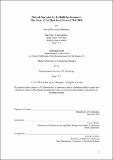| dc.contributor.advisor | Nasser Rabbat. | en_US |
| dc.contributor.author | Almogren, Nawaf Bin Ayyaf(Nawaf Bin Abdulaziz Bin Ayyaf) | en_US |
| dc.contributor.other | Massachusetts Institute of Technology. Department of Architecture. | en_US |
| dc.date.accessioned | 2020-10-08T21:27:23Z | |
| dc.date.available | 2020-10-08T21:27:23Z | |
| dc.date.copyright | 2020 | en_US |
| dc.date.issued | 2020 | en_US |
| dc.identifier.uri | https://hdl.handle.net/1721.1/127856 | |
| dc.description | Thesis: S.M. in Architecture Studies, Massachusetts Institute of Technology, Department of Architecture, May, 2020 | en_US |
| dc.description | Cataloged from the official PDF of thesis. | en_US |
| dc.description | Includes bibliographical references (pages 97-99). | en_US |
| dc.description.abstract | Diriyah is a parched settlement in the arid deserts of Central Arabia. It went, very swiftly, from not differing much compared to its local sphere, to assuming the role of a beacon capital which controlled Arabia almost in its entirety. From its ambitious emergence in 1744- which stemmed from a historical pact between political authority and religious influence, until its punitive downfall in 1818- after assuming the role of a bunker under siege for six long months, Diriyah witnessed numerous political stages which effected its built environment. Between a dire need to defend and fortify at one point, and an eager desire to show luxuriousness and grandeur at another, Diriyah's built environment became a shimmering pond reflecting the ever-shifting political status of the state at any given time. By relying on historical textual accounts, infused with visual means of analysis, this thesis explores, and narrates, the urban development history of Diriyah during the timeframe of the First Saudi State (1744-1818), through using its built environment as a main examination tool. Accordingly, Atturaif historic district in Diriyah, was chosen as an urban model which directly stemmed as a result of establishing the state under the double weight of politics and religion. Located on an elevated majestic plateau, Atturaif became the center of power, and the decision-making hub of the ever-growing ambitious state. Hence, its urban form was examined, its core elements investigated, and notions of its symbolism analyzed. Eventually, the project described herein argues that the urban story of Diriyah presented an interesting model to analyze. How a strategic pact between the two different entities of politics and religion came together to turn a small patch of land, amongst ever-battling tribally-ruled settlements, into a capital of a State which possessed the largest extent of influence in the Arabian Peninsula since the 7th century. | en_US |
| dc.description.statementofresponsibility | by Nawaf Bin Ayyaf Almogren. | en_US |
| dc.format.extent | 99 pages | en_US |
| dc.language.iso | eng | en_US |
| dc.publisher | Massachusetts Institute of Technology | en_US |
| dc.rights | MIT theses may be protected by copyright. Please reuse MIT thesis content according to the MIT Libraries Permissions Policy, which is available through the URL provided. | en_US |
| dc.rights.uri | http://dspace.mit.edu/handle/1721.1/7582 | en_US |
| dc.subject | Architecture. | en_US |
| dc.title | Diriyah narrated by Its built environment : the story of the first Saudi State (1744-1818) | en_US |
| dc.title.alternative | Story of the first Saudi State (1744-1818) | en_US |
| dc.type | Thesis | en_US |
| dc.description.degree | S.M. in Architecture Studies | en_US |
| dc.contributor.department | Massachusetts Institute of Technology. Department of Architecture | en_US |
| dc.identifier.oclc | 1196034922 | en_US |
| dc.description.collection | S.M.inArchitectureStudies Massachusetts Institute of Technology, Department of Architecture | en_US |
| dspace.imported | 2020-10-08T21:27:23Z | en_US |
| mit.thesis.degree | Master | en_US |
| mit.thesis.department | Arch | en_US |
